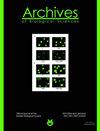三磷酸腺苷和蛋白激酶a在离体大鼠心肌细胞力频关系中的作用
IF 0.8
4区 生物学
Q4 BIOLOGY
引用次数: 0
摘要
啮齿类动物的生理心率约为4-6 Hz,尽管在分离的心肌细胞中,通常采用1 Hz的刺激频率来研究心肌生理学和病理生理学中收缩-松弛周期的变化。我们研究了1、2和4 Hz刺激下离体心肌细胞的收缩参数,以及ATP和蛋白激酶A (PKA)在离体心肌细胞力频关系中的作用。细胞的收缩和细胞内Ca2+的变化同时记录在细胞刺激的6-8 V振幅的脉冲频率为1,2和4赫兹。刺激频率增加导致缩短百分比显著降低,舒张率减慢,舒张Ca2+水平显著升高,但对收缩率和Ca2+瞬态无影响。ATP和n6 -苯甲酰腺苷-3?-5?-环单磷酸腺苷(6-BNZcAMP)引起收缩幅度和速度的增加,与刺激频率成正比,但对松弛时间没有影响。实验结果表明,力刺激频率与离体肌细胞呈负相关,能量代谢和肾上腺素能系统可能与此相关。本文章由计算机程序翻译,如有差异,请以英文原文为准。
Role of adenosine triphosphate and protein kinase a in the force-frequency relationship in isolated rat cardiomyocytes
The physiological heart rate of rodents is around 4-6 Hz, although a stimulus frequency of 1 Hz is generally used in isolated cardiomyocytes to study changes in the contraction-relaxation cycle in cardiac muscle physiology and pathophysiology. Our study investigated the contraction parameters in isolated cardiomyocytes at 1, 2 and 4 Hz stimulation, and the roles of ATP and protein kinase A (PKA) in the force-frequency relationship in isolated cardiomyocytes. The contraction of the cell and intracellular Ca2+ changes were recorded simultaneously during cell stimulation by applying pulses of 6-8 V amplitude with frequencies of 1, 2 and 4 Hz. The increase in stimulus frequency caused a significant decrease in the percentage of shortening, relaxation times, slowing of the relaxation rate, and a significant increase in diastolic Ca2+ levels, but had no effect on the contraction rate and Ca2+ transients. Administration of ATP and N6-benzoyladenosine-3?-5?-cyclic monophosphate (6-BNZcAMP) caused an increase in contraction amplitude and speed which were proportional to the stimulus frequency but had no effect on the relaxation times. The experimental results show that the forcestimulus frequency has a negative correlation in isolated myocytes and that energy metabolism and the ?-adrenergic system may be responsible for this relationship.
求助全文
通过发布文献求助,成功后即可免费获取论文全文。
去求助
来源期刊
CiteScore
1.40
自引率
0.00%
发文量
25
审稿时长
3-8 weeks
期刊介绍:
The Archives of Biological Sciences is a multidisciplinary journal that covers original research in a wide range of subjects in life science, including biology, ecology, human biology and biomedical research.
The Archives of Biological Sciences features articles in genetics, botany and zoology (including higher and lower terrestrial and aquatic plants and animals, prokaryote biology, algology, mycology, entomology, etc.); biological systematics; evolution; biochemistry, molecular and cell biology, including all aspects of normal cell functioning, from embryonic to differentiated tissues and in different pathological states; physiology, including chronobiology, thermal biology, cryobiology; radiobiology; neurobiology; immunology, including human immunology; human biology, including the biological basis of specific human pathologies and disease management.

 求助内容:
求助内容: 应助结果提醒方式:
应助结果提醒方式:


